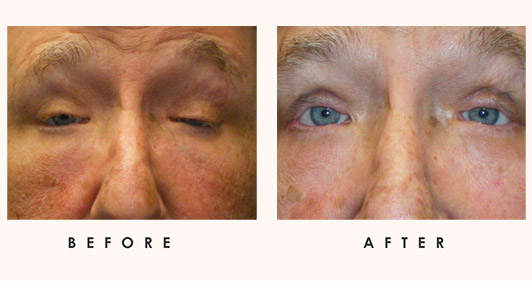Orbit Anatomy
Jump To
Anatomically, the orbit is the cavity of the skull in which the eye and its appendages are located. “Orbit” can refer to the bony socket, or it can also be used to imply the contents. Some orbital anatomical findings:
- Thinnest in body, no subcutaneous fat
- Upper lid crease (fold) is levator, attached to pretarsal orbicularis and skin; located at level of sup border of tarsus
- Upper puntca is more medial
- Mucocutaneous border is post to meibomian gland level
- Gray line = muscle of Riolan (superficial orbicularis)
- Zeus, sebaceous glands (holocrine) with cilia
- Moll glands (only apocrine gland on lid) with skin
- 100 lashes on upper lid, 50 on lower
- Extensive anastamosis between supraorbital, lacrimal branches of ophthalmic a. (from internal carotid) and angular and temporal a. (from ext carotid)
- Venous drainage: pretarsal, poatarsal
- No lymphatics for the orbit except in conjunctiva
- Eyelid medial lymphatics drain to submandibular nodes and laterally to preauricular nodes
Subcutaneous tissue
A description of the subcutaneous tissue, or soft tissue architecture, is presented below:
- No fat, loose connective tissue holds fluid in preseptal > pretarsal area b/c less firmly attached
- Main protractor
- Supplied by Cranial Nerve VII, narrows PF, helps lacrimal pump orbital
- Voluntary sphincter (wink, blepharospasm)
- Origin at medial canthal tendon and corrugator supercilius muscle
- Palpebral (pretarsal & preseptal)
- Reflex blink and involuntary
- Pretarsal origin at post lacrimal crest (most important to keep lid opposed to globe to let punctum lie in tear lake ) & ant limb of med canthal tendon; deep head of pretarsal m. (Horner’s tensor tarsi) encircles canaliculi to facilitate tear drainage
- Upper & lower segments of pretarsal orb m. fuse to become lateral canthal tendon
- Pretarsal muscle firmly adherent
- Pretarsal muscle of Riolan = gray line = superficial orbicularis
- Extension of periosteum
- In non-Asians, upper lid septum fuses w/levator aponeurosis. 2-5 mm above sup tarsal border; in lower lid it fuses w/capsulopalpebral fascia at or just below inf tarsal border
- Passes medially in front of trochlea
- Barrier to hemorrhage and infection between lid and orbit
- Orbital fat can herniate through septum into lids causing bags
- Central orbital fat pad lies behind septum, in front of levator aponeurosis
- Dense connective tissue, attach med & lat to periosteum
- 1 x 29 x 11 mm upper lids, 4 mm vertical height in lower lids
- Meibomian glands are modified holocrine glands
- In upper lid marginal arcade lies 2 mm sup to lid margin, ant to tarsus
- Peripheral art arcade is sup to tarsus, between levator aponeurosis, Muller’s
Lacrimal Anatomy
Lacrimal Gland
- Separated from orbit by fibroadipose tissue
- Divided by LPS aponeurosis, smaller palpebral portion visible, larger orbital half hidden
- Blood vessels, lymph, nerve, and excretory ducts pass from orbital part through palpebral section
- don’t biopsy or remove palpebral lobe which might significantly reduce tearing
- Ducts empty 5mm above superior tarsal border
- Reflex tear arc: afferent from V stimulates tear production from lacrimal gland; efferent complicated (with parasympathetics from VII, sympathetics not understood)
- Exocrine gland, acinar and myoepithelial cells, lacrimal artery
Accessory Glands of Krause and Wolfring
- No neural control, basal tear production (BST)
- Located in sup fornix & above sup border of tarsus
Canalicular System
- Puncta sit in tear lake, approx 6mm from canthus, then 2 mm ampulla, then canaliculi extend medially 8-10 mm to common canaliculus (in 90% of population), then to lat wall of tear sac
- Dilation prior to sac: sinus of Maier, enters sac superior and posterior
- Valve of Rosenmuller prevents reflux from sac into common canaliculus during tear pump
- Sac lies btw ant and post crura of med canthal tendon in lacrimal sac fossa
- Puncta/lids move medially with lid closure
- Deep heads of preseptal orbicularis (Horner’s muscle) inserts on post lacrimal crest, lateral half of superior lacrimal sac, encircles canaliculi to help pump
Bony System
- Interosseos direction of Nasolacrimal Duct = inferior and slightly. lateral, posterior
- Nasolacrimal Duct is approx 12 mm long, intranasal ostium high up in inf turbinate, covered by valve of Hasner, approx 2.5 cm post to naris on lat wall
- Lacrimal bone very thin, therefore aim posteriorly in DCR
- Ethmoid air cells are at superior and deeper parts of fossa, but might possibly extend under entire fossa
- Mucosa of ethmoid cells gray, thin, and friable
Lacrimal Pump Model
- Orbicularis actively pumps tears from lake
- Rosengren-Doane model: orb m contraction > pressure in lacrimal sac > tears forced into nose > lids open, move laterally > – pressure in sac helped by closed valve of Hasner > lids open fully and puncta pop open, with – pressure drawing tears into ampulla and canaliculi
- Jones model: closure–lateral move = negative pressure
- Becker model: closure–upper half lateral move = lower pressure, lower half medial move with higher pressure
- Fistulas develop inferior to medial canthal tendon b/c tendon itself is tough



